How Accessible is Chicago Transit to Persons with Disabilities?
Chicago has an extensive transit system spanning seven different elevated train lines and hundreds of bus routes. Some of these lines run 24 hours a day. But how accessible is this transit wealth to Chicagoans with disabilities? And are there disparities in access between the disabled and non-disabled population?
These are questions the Voorhees Center tackled as part of the ADA-Participatory Action Research Consortium Project, a collaborative research project that brings together ADA Centers across the US, universities, and community partners to examine data and disparities around disability. To answer these questions, we looked at two factors: (1) how close persons with (and without) disabilities live to transit, and (2) how many stations and vehicles are ADA accessible.
Proximity to Transit
A major factor affecting one’s ability to ride transit is how close one lives to a station or bus stop. Using GIS software, we analyzed the proportion of persons with and without disabilities that live near transit.
Number of Persons with Disabilities and Train Station Locations
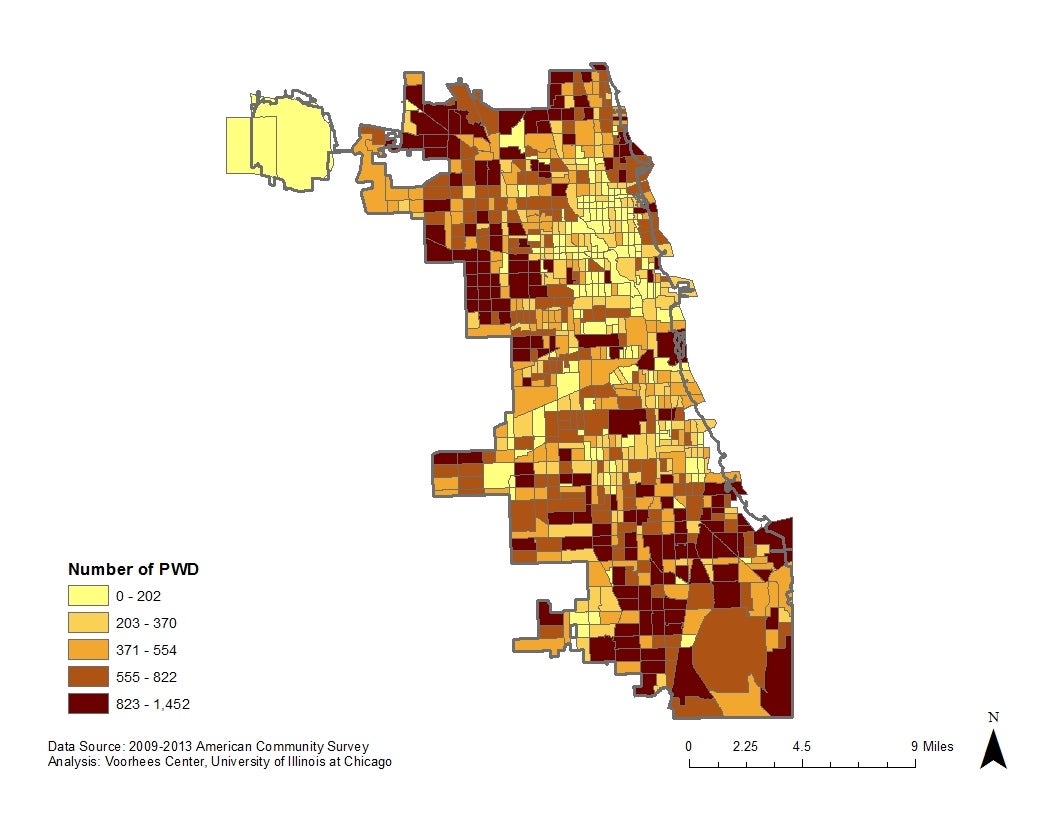
Number of Persons with Disabilities and Train Station Locations
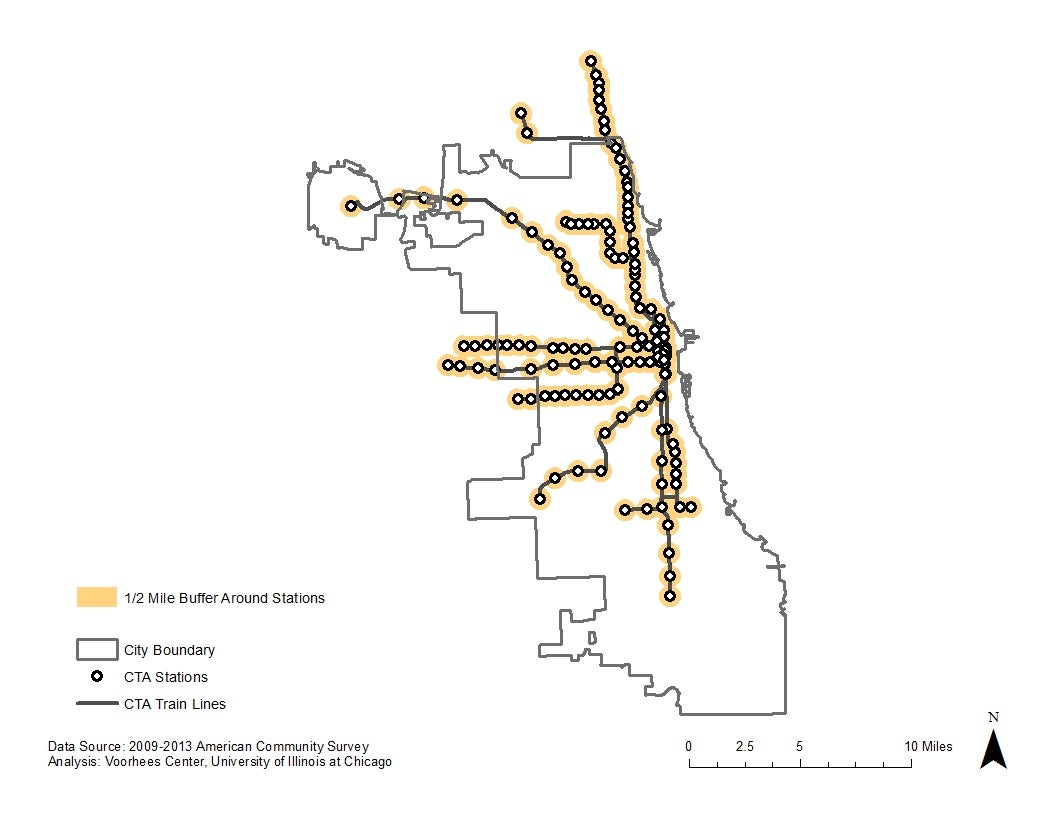
Number of Persons with Disabilities and Train Station Locations
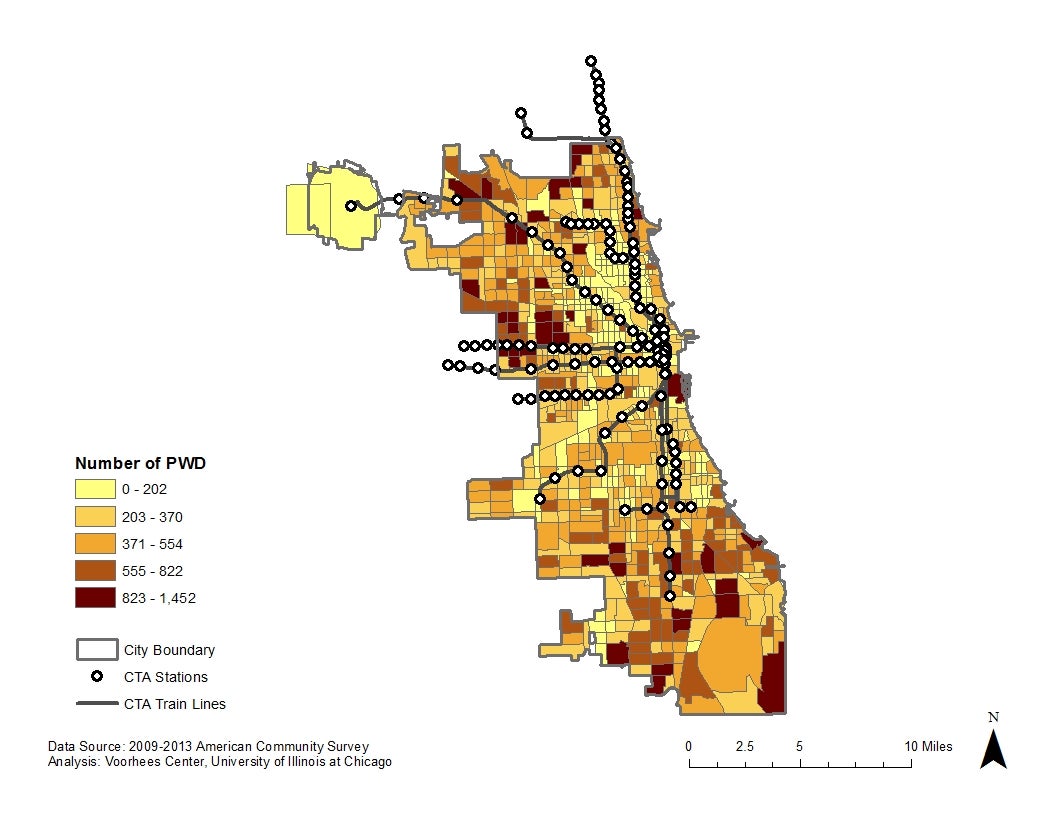
Disabilities Act
To assess proximity to train lines, we first determined the number of people living within 1/2 mile of a station. One-half mile is the standard distance used in transit planning to calculate a station’s ‘walk shed,’ or the catchment area around transit service that generates walk ridership. (Of course, proximity does not necessarily mean accessibility, as this does not take into account sidewalk conditions or mobility impairments, but it is a good starting point to understand access). Our analysis found that 34% of all Chicagoans and 31% of Chicagoans with disabilities live within 1/2 mile of a station. But only 67% of CTA rail stations are ADA accessible. If we only consider accessible stations, proportions living within 1/2 mile of a station drop to 24% of persons with disabilities and 26% of all Chicagoans. There are many factors contributing to this disparity in proximity between individuals with and without disabilities, but a central one is housing affordability. Housing adjacent to train lines tends to be more expensive, which can be cost prohibitive to persons with disabilities with limited incomes.
Similarly, we analyzed proximity to bus stops using 1/4 of a mile to calculate walk shed and found that 93% of all Chicagoans and 94% of Chicagoans with disabilities live within 1/4 mile of a bus stop.
1/4 Mile Buffer Around CTA Bus Stop
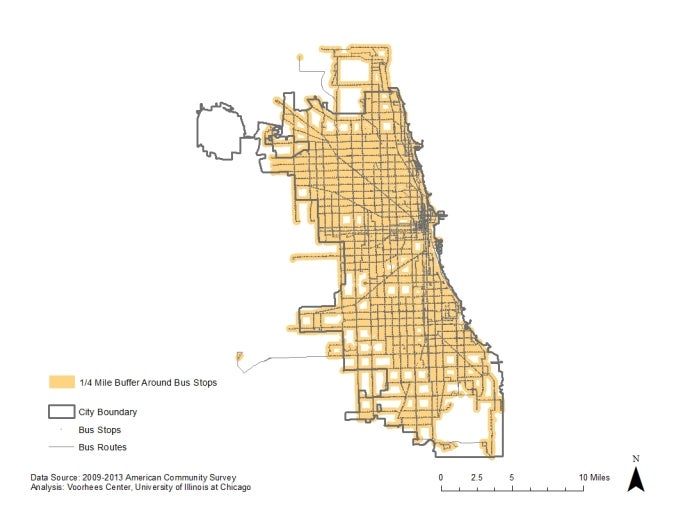
Vehicle Accessibility
Vehicle Accessibility
According to data from the National Transit Database (NTD), 100% of Chicago Transit Authority (CTA) vehicles are ADA accessible. This includes a fleet of over 1,300 train cars and 1,800 buses.
Station Accessibility
Sixty-seven percent, or 97 out of 145 CTA train stations are ADA accessible according to NTD data. As an older transit system built largely before the passage of the Americans with Disabilities Act in 1990, many stations still lack elevators or other accessibility elements. If a station undergoes renovations, it must be brought up to ADA standards. A current example is the Wilson Red Line station, one of the biggest renovation projects undertaken by the CTA. Built in 1923, the station is not currently ADA accessible, but will be after renovations are complete.
Accessible and Non-Accessible Stations
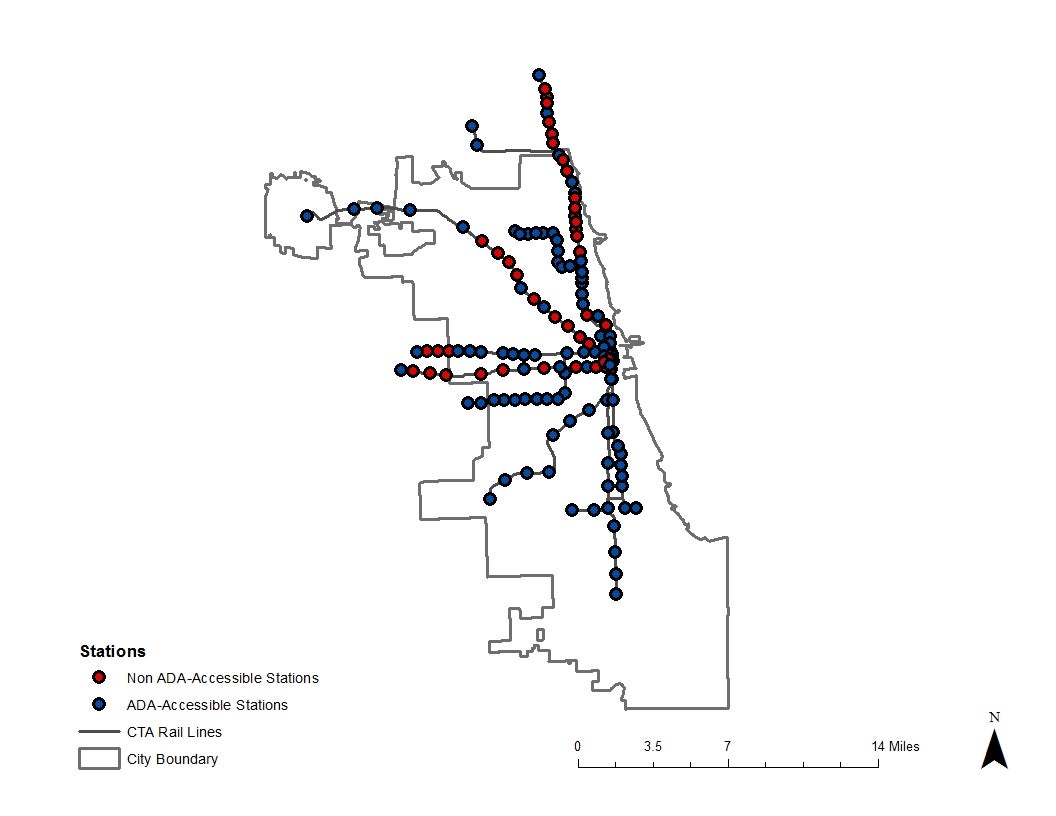
Accessible and Non-Accessible Stations
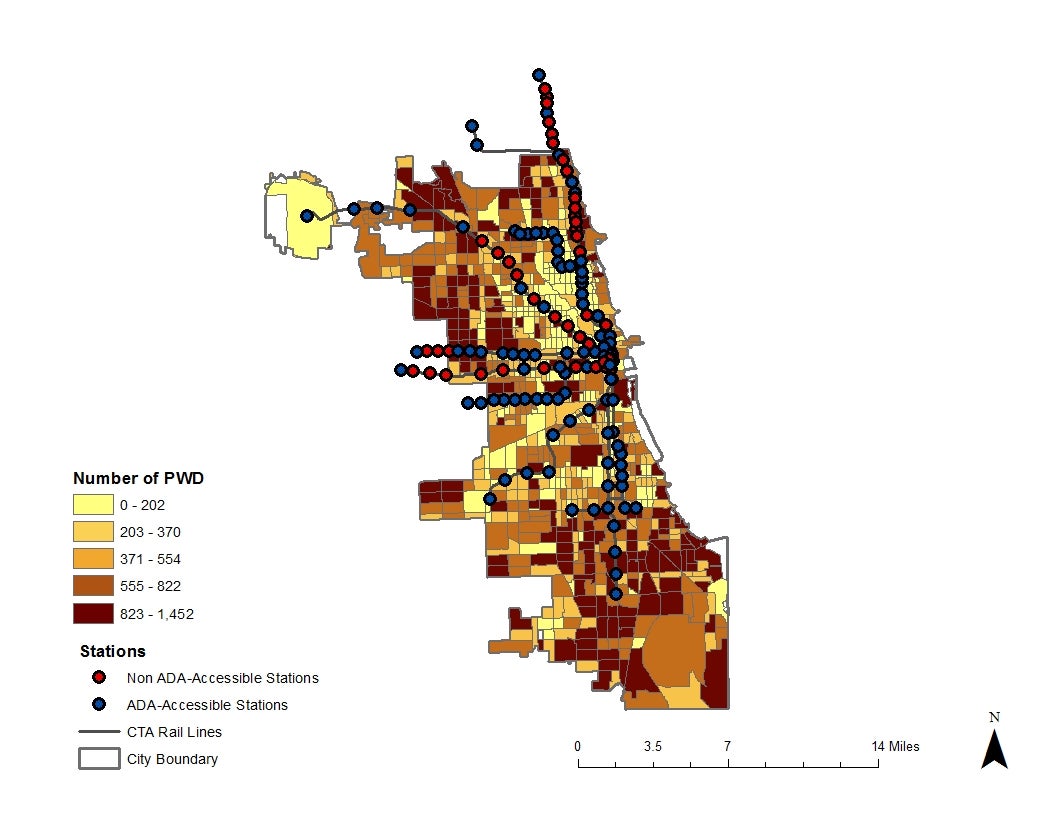
Accessible and Non-Accessible Stations on Chicago’s North Side
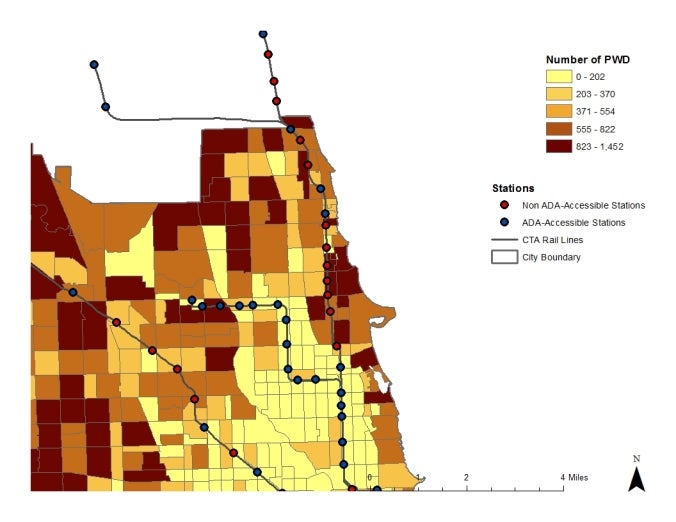
Chicago’s Wilson Red Line Station, currently under renovations that will make the station ADA accessible, is located along a string of non-accessible stations in the Uptown neighborhood, which contains a high number of residents with disabilities.
Reasons Why Investments in Accessibility are Important
Unfortunately, there is not a comprehensive source for bus stop accessibility. While all buses are equipped with accessible ramps, stops themselves may not be located in spots that are easily navigable.
Reasons Why Investments in Accessibility are Important
Paratransit is expensive (and inconvenient)
Under Department of Transportation ADA regulations, transit agencies operating a fixed route transportation system must provide paratransit or other special services to individuals with disabilities comparable to the level of service provided to individuals without disabilities who use the fixed route system. In Chicago, paratransit services are provided by Pace Bus. Paratransit is an essential service to many riders with disabilities. However, increasing ridership on the fixed route systems is of interest to both riders and providers. The ability to get on and off a fixed route system whenever one chooses allows riders a much greater degree of freedom when compared to having to call ahead to schedule paratransit rides at specific times. From a transit provider perspective, paratransit is expensive. According to NTD figures, a single paratransit ride costs over $30 to provide compared to a single fixed route bus trip which costs on average less than $4.
Demographic Trends Mean Increased Demand
As the Baby Boom generation continues to age and outlive their driving years, we will see unprecedented demand in senior services including transportation. Increasing transit ridership through better accessibility will provide a way for non-driving seniors to continue to live active lives, allowing more seniors to age in place while curbing costs associated with demand-response systems.
Accessibility Benefits Everyone
Just like any boon to livability or other aspects of quality of life, transit accessibility enhancements, whether its station elevators, improved sidewalk conditions, or more easily navigable stations, stand to benefit all residents, not just those with disabilities.
For more about the ADA-PARC project, visit www.adaparc.org. The ADA-PARC is funded by the U.S. Department of Education, National Institute for Disability and Rehabilitation Research under grant H133A120008, from 2012 – 2017.